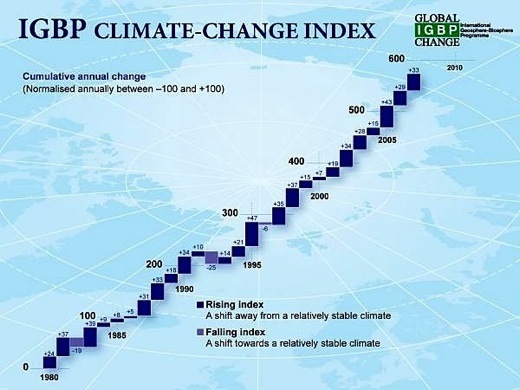 Image above: IGBP Climate-Change Index 1980-2007
Some people still question whether Earth's climate is changing as rapidly and profoundly as the majority of climate scientists suggest. But, what if the complexity of the Earth's climate were distilled down to one number, in the same way that the Dow Jones Index condenses volumes of data into a single figure? What, then, would be the general trend?
The IGBP Climate-Change Index is a first attempt to do just that. It brings together key indicators of global change: carbon dioxide, temperature, sea level and sea ice. The index gives an annual snapshot of how the planet's complex systems -- the ice, the oceans, the land surface and the atmosphere -- are responding to the changing climate. The index rises steadily from 1980 -- the earliest date the index has been calculated. The change is unequivocal, it is global, and, significantly, it is in one direction. The reason for concern becomes clear: in just 30 years we are witnessing major planetary-scale changes.
Image above: IGBP Climate-Change Index 1980-2007
Some people still question whether Earth's climate is changing as rapidly and profoundly as the majority of climate scientists suggest. But, what if the complexity of the Earth's climate were distilled down to one number, in the same way that the Dow Jones Index condenses volumes of data into a single figure? What, then, would be the general trend?
The IGBP Climate-Change Index is a first attempt to do just that. It brings together key indicators of global change: carbon dioxide, temperature, sea level and sea ice. The index gives an annual snapshot of how the planet's complex systems -- the ice, the oceans, the land surface and the atmosphere -- are responding to the changing climate. The index rises steadily from 1980 -- the earliest date the index has been calculated. The change is unequivocal, it is global, and, significantly, it is in one direction. The reason for concern becomes clear: in just 30 years we are witnessing major planetary-scale changes. The index dips in just three years, 1982, 1992 and 1996 and looks effective at capturing major natural events that affect climate, and their knock-on effect on the planet. The dip in the curve in 1992 may have been caused by the massive Mount Pinatubo volcanic eruption in the Philippines in 1991. The eruption was large enough to affect temperature and sea level on a planetary scale.
The other falls coincide with the El Chichon volcanic eruption in Mexico in 1982 and the volcanic eruption on the Caribbean island of Montserrat in 1996. If this link proves robust, the index is an excellent visual tool to show how external events can have rapid planetary-scale effects. Of course, the overall direction of change -- a climbing cumulative index -- highlights the extent human activities are having on the planet's climate system.
The idea came about when several IGBP scientists including Steven Running, IGBP executive director Sybil Seitzinger, former IGBP director Kevin Noone, Kathy Hibbard, Mark Stafford Smith, Peter Cox, Suzi Kerr and Pierre Friedlingsten realised that the way various global datasets are reported throughout the year may be confusing. It is uncoordinated, there are a variety of unfamiliar units, and natural variability sometimes masks a trend.
Professor Seitzinger says, "We felt people outside global-change research are not clear about the scale of the changes scientists are witnessing. The index is a response to these concerns."
Why those four metrics? Professor Steven Running from the University of Montana says, "The iconic Mauna Loa atmospheric CO2 concentration was obvious. Global air temperature is already widely reported at the end of each calendar year, so that was a logical choice too.
"We needed an oceanic measure and chose sea-level rise because the impact is global and of high public interest. The fourth metric concerns the cryosphere. Growing concern about the rate of loss of summer sea-ice in the Arctic led us to choose this metric. This parameter broadly represents the Earth system and it is interesting the summer sea-ice extent is shrinking much faster than models predicted five, ten years ago," said Professor Running, a lead author on the Intergovernmental Panel on Climate Change Fourth Assessment Report.
In the future, other variables could be added. "We did not identify any good land surface variable, because no good standard exists," says Professor Running. "But some day we may have annual albedo or land-cover change."
Each parameter is normalised between -100 and +100. Zero is no annual change. One hundred is the maximum-recorded annual change since 1980. The normalised parameters are averaged. This gives the index for the year. The value for each year is added to that of the previous year to show the cumulative effect of annual change.
Professor Running says, "Some of us thought we'd need a five-year rolling average to help dampen fluctuations and to elucidate core trends. But when we first produced the index it was obvious this was unnecessary: the index highlights the trend extremely effectively."
The index has been developed with input from a large number of scientists involved in global-change research. Some scientists questioned whether atmospheric carbon dioxide levels should be included. They argued that, because carbon dioxide drives changes in the three other parameters, it should be excluded. But others argue that it is human activity that is the external forcing agent. Additionally, as atmospheric carbon dioxide levels fluctuate, this in turn affects the effectiveness of other major carbon sinks: the oceans and the land. So, given the size of its influence on the climate, the arguments to include atmospheric carbon dioxide levels outweigh arguments for exclusion. Recalculating the index without carbon dioxide shows that carbon dioxide does not dominate the trend.
IGBP scientists are discussing developing other indices relating to global change such as an index including land-use, fisheries exploitation, population, fire and extreme events, as well as backdating the new index.
The index will be updated annually.
No comments :
Post a Comment